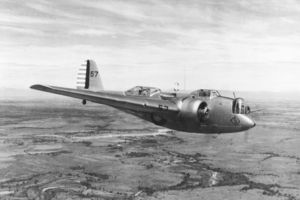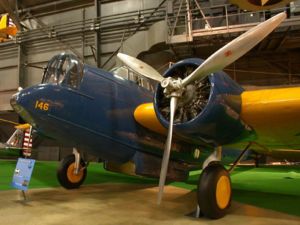PlaneSpottingWorld welcomes all new members! Please gives your ideas at the Terminal.
Martin B-10

From the Maxwell Air Force Base website (original image).
The Martin B-10 was the first all-metal monoplane bomber to go into regular use by the United States Army Air Corps, entering service in June 1934. It was also the first mass-produced bomber whose performance was superior to that of the Army's pursuit aircraft of the time.
The B-10 served as the airframe for the B-12, B-13, B-14, and A-15 designations.
The B-10 began a revolution in bomber design. Its all-metal monoplane build, along with its features of closed cockpits, rotating gun turrets, retractable landing gear, internal bomb bay, and full engine cowlings, would become the standard for decades. It made all existing bombers completely obsolete. In 1932, Martin received the Collier Trophy for designing the XB-10.
Contents
B-10

The XB-10 began as the Martin Model 123, a private venture by the Glenn L. Martin Company of Baltimore, Maryland. It had a crew of four: pilot, copilot, nose gunner, and fuselage gunner. As in previous bombers, the four crew compartments were open, but it had a number of design innovations as well. The most important of these were a deep belly for an internal bomb bay and retractable main landing gear. Its 600 hp (447 kW) engines allowed for significant power. It first flew on 1932 February 16, and was delivered for testing to the U.S. Army on March 20.
The XB-10 delivered to the Army was slightly different from the original aircraft. Where the Model 123 had ring engine cowlings, the XB-10 had full engine cowlings to decrease drag. It also sported a fully rotating glass turret for the nose gunner, more powerful engines, and an eight-foot increase in the wingspan. When the XB-10 flew during trials in June, it recorded a speed of 197 mph (317 km/h) at 6,000 ft (1830 m). This was an impressive performance for 1932.
Following the success of the XB-10, a number of changes were made, including reduction to a three-man crew, addition of canopies for all crew positions, and an upgrade to 675 hp (503 kW) engines. The Army ordered 48 of these on 1933 January 17.
The first 14 aircraft were designated YB-10 and delivered to Wright Field, starting in November 1933. The production model of the XB-10, the YB-10 was very similar to its prototype.
The Martin Model 139 was the export version of the Martin B-10. With an advanced performance, the Martin company fully expected that export orders for the B-10 would come flooding in.
The Army owned the rights to the Model 139 design. Only once the Army's orders had been filled, in 1936, Martin received permission to export Model 139s, and delivered versions to the air forces of Argentina, China, The Netherlands, the Netherlands East Indies, Siam, The USSR (one only, for evaluation), and Turkey. For example, 6 Model 139Ws were sold to Siam in April of 1937, powered by Wright R-1820-G3 Cyclone engines; 20 Model 139Ws were sold to Turkey in September of 1937, powered by R-1820-G2 engines. The B-10's obsolescence was proved by the quick defeat of B-10B squadrons by Japanese Zeros during the invasions of the Dutch East Indies and China.
One of the Argentine YB-10s was returned to the United States in 1976, refurbished, and is now on display in the National Museum of the United States Air Force at Wright-Patterson AFB in Ohio. It is likely the sole surviving B-10 in the world. Various parts of crashed B-10s, such as turrets and wings, were retrieved from the jungle of Borneo and are now on display in the Militaire-Luchtvaartmuseum (Military Aviation Museum) at Soesterberg, the Netherlands.
The YB-10A was different from a YB-10 only in its engines. It used Wright R-1820-31 turbo-supercharged radials, allowing it to attain speeds of 236 mph (380 km/h). This made it the fastest plane of the B-10–series. Despite this advantage, only one was built, as a test aircraft.
In 1935 the Army ordered an additional 103 aircraft designated B-10B. These had only minor changes from the YB-10. Shipments began in 1935 July. B-10Bs served with the 2nd Bomb Group at Langley Field, the 9th Bomb Group at Mitchel Field, the 19th Bomb Group at March Field, the 6th Bomb Group in the Panama Canal Zone, and the 28th Bomb Group in the Philippines.
The rapid advances in bomber design in the 1930s meant that the B-10 was eclipsed by the B-17 Flying Fortress and B-18 Bolo before the United States entered World War II. But at the time of its creation, the B-10B was so advanced that General Henry H. Arnold described it as the air power wonder of its day. It was 1.5 times as fast as any biplane bomber, and faster than any contemporary fighter.
B-12
Of the 48 aircraft made on an XB-10 frame ordered by the army, 7 were YB-12s, ordered for service in 1933. These were essentially a B-10–airframe modified to use Pratt & Whitney R-1690-11'Hornet' radial engines. These 775 hp (578 kW) engines gave similar performance to those on the B-10B (218 mph (351 km/h)).
The production version of the YB-12, the B-12A constituted 25 of the 48 XB-10–airframes. It featured an extra 365 US gal (1381 L) tank, giving the B-12A a combat range of 1,240 miles (1995 km).
XB-13
The XB-13 was a version of the B-10 utilising Pratt & Whitney R-1860-17 radial engines. Ten were on order but cancelled before production started.
XB-14
The last of the 48 XB-10–airframes ordered by the army, the XB-14 was a version of the B-10 using Pratt & Whitney YR-1830-9 Twin Wasp radial engines.
A-15
The XA-15 was a proposed attack variant of the YB-10, was never built; the contract fell to the A-14 Shrike.
Specifications (B-10A)
General characteristics
- Crew: 3
- Length: 44 ft 9 in (13.6 m)
- Wingspan: 70 ft 6 in (21.5 m)
- Height: 15 ft 5 in (4.7 m)
- Wing area: 678 ft² (63 m²)
- Loaded weight: 14,700 lb (6,680 kg)
- Max takeoff weight: 16,400 lb (7,440 kg)
- Powerplant: 2× Wright R-1820-33 "Cyclone" radials, (578 kW) each
Performance
- Maximum speed: 215 mph (187 kt, 346 km/h)
- Cruise speed: 183 mph (159 kt, 294 km/h)
- Range: 1,370 mi (1,190 nm, 2,200 km)
- Service ceiling: 24,200 ft (7,380 m)
- Wing loading: 21.7 lb/ft² (106 kg/m²)
- Power/mass: 0.105 hp/lb (173 W/kg)
Armament
- Guns: 3× .300 in (7.26 mm) Browning machine guns
- Bombs: 2,260 lb (1,030 kg)
Surviving aircraft
The only known B-10 to still be intact is at the National Museum of the United States Air Force at Wright-Patterson Air Force Base near Dayton, Ohio. The aircraft on display is painted as a B-10 used in the 1934 Alaskan Flight. It was an export version sold to Argentina in 1938. Donated by the Government of Argentina to the U.S. Government for display in the museum in 1970, it was restored by the 96th Maintenance Squadron (Mobile), Air Force Reserve, at Kelly Air Force Base, Texas, in 1973-1976. [1]
External links
Related content
Comparable aircraft
Designation sequence
Related lists
Lists relating to aviation | |
|---|---|
| General | Timeline of aviation · Aircraft · Aircraft manufacturers · Aircraft engines · Aircraft engine manufacturers · Airports · Airlines |
| Military | Air forces · Aircraft weapons · Missiles · Unmanned aerial vehicles (UAVs) · Experimental aircraft |
| Notable incidents and accidents | Military aviation · Airliners · General aviation · Famous aviation-related deaths |
| Records | Flight airspeed record · Flight distance record · Flight altitude record · Flight endurance record · Most produced aircraft |
